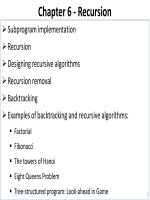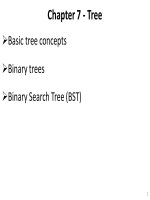Data Structures and Algorithms - Chapter 3 -STACK ppt
Bạn đang xem bản rút gọn của tài liệu. Xem và tải ngay bản đầy đủ của tài liệu tại đây (252.4 KB, 31 trang )
Chapter 3 - STACK
Definition of Stack
Specifications for Stack
Implementations of Stack
Linked Stack
Contiguous Stack
Applications of Stack
1
Linear List Concepts
LIFO
(Stack)
2
Stack ADT
DEFINITION: A Stack of elements of type T is a finite sequence
of elements of T, in which all insertions and deletions are
restricted to one end, called the top.
Stack is a Last In - First Out (LIFO) data structure.
Basic operations:
• Construct a stack, leaving it empty.
• Push an element.
• Pop an element.
• Top an element.
3
Basic operation of Stack (Push)
Before After
push data
push data
(Stack
remains
unchanged)
top
top
top
top
a) Successful operation: function returns success
b) Unsuccessful operation: function returns overflow
4
Basic operation of Stack (Pop)
Before After
pop data
pop data
(Stack
remains
unchanged)
top
top
a) Successful operation: function returns success
b) Unsuccessful operation: function returns underflow
5
Before After
Received data:
Stack remains
unchanged
Basic operation of Stack (Top)
top data
top data
(Stack
remains
unchanged)
top
top
XX
a) Successful operation: function returns success
b) Unsuccessful operation: function returns underflow
X
6
Stack ADT (cont.)
Extended operations:
• Determine whether the stack is empty or not.
• Determine whether the stack is full or not.
• Find the size of the stack.
• Clear the stack to make it empty.
• Determine the total number of elements that have
ever been placed in the stack.
• Determine the average number of elements
processed through the stack in a given period.
• …
7
Specifications for Stack ADT
<void> Create()
<ErrorCode> Push (val DataIn <DataType>)
<ErrorCode> Pop ()
<ErrorCode> Top (ref DataOut <DataType>)
<boolean> isEmpty ()
<boolean> isFull ()
<integer> Size () // the current number of elements in the stack.
Variants of similar methods:
ErrorCode Pop (ref DataOut <DataType>)
…
8
Built a Stack ADT
Stack may be fully inhirited from a List ADT, inside its operations
calling List’s operations.
Ex.:
<ErrorCode> Push (val DataIn <DataType>)
// Call List::InsertHead(DataIn)
or
// Call List::Insert(DataIn, 0) // 0: insert to the 1
st
position
end Push
<ErrorCode> Pop ()
// Call List::RemoveHead()
end Pop
Other operations of Stack are similar …
9
Built a List ADT from Stack ADT
If the Stack ADT has been built first, List ADT may be
inhirited from the Stack. Some of its operations call
Stack’s operations; the others will be added.
10
Implementations of Stack
Contiguous Implementation: use an array.
(May be Automatically or Dynamically Allocated Array)
Linked Implementation: linked stack.
11
Linked Stack
a) Conceptual b) Physical
Node
Data <DataType>
link <pointer>
end Node
Stack
top <pointer>
count <integer>
end Stack
4
count
top
top
12
Create Linked Stack
<void> Create ()
Creates an empty linked stack.
Pre none
Post An empty linked stack has been created.
1. top = NULL
2. count = 0
3. return
end Create
13
top
count = ?
?
top
count = 0
top = NULL
count = 0
Push data into a Linked Stack
1. Allocate memory for the new node and set up data.
2. Update pointers and count:
• Point the new node to the top node.
• Point top to the new node.
14
count
top
…
X
pNew
n
count
top
…
X
pNew
n+1
X
pNew->link = top (1)
top = pNew (2)
count = count + 1
(1)
(2)
Push data into a Linked Stack
(cont.)
• Push is successful when allocation memory for the
new node is successful.
• There is no difference between push data into a stack
having elements and push data into an empty stack
(top having NULL value is assigned to pNew->link: that’s
corresponding to a list having only one element).
15
count
top
1
pNew
count
top
0
pNew
pNew->link = top
top = pNew
count = count + 1
Push Algorithm (cont.)
<ErrorCode> Push (val DataIn <DataType>)
Pushes new data into the stack.
Pre DataIn contains data to be pushed.
Post If stack is not full, DataIn has been pushed in;
otherwise, stack remains unchanged.
Return success or overflow.
16
Push Algorithm (cont.)
<ErrorCode> Push (val DataIn <DataType>)
// For Linked Stack
1. Allocate pNew
2. If (allocation was successful)
1. pNew->data = DataIn
2. pNew->link = top
3. top = pNew
4. count = count + 1
5. return success
3. Else
1. return overflow
end Push
17
pNew
count
top
n+1
X
…
count
top
1
pNew
Pop Linked Stack
1. pDel holds the element on the top of the stack.
2. top points to the next element.
3. Recycle pDel. Decrease count by 1.
top
…
pDel
count n
top
…
pDel
count n-1
X
top = pDel->link
recycle pDel
count = count -1
18
Pop Linked Stack (cont.)
• Pop is successful when the stack is not empty.
• There is no difference between pop an element
from a stack having elements and pop the only-
remained element in the stack (pDel->link having
NULL value is assigned to top: that’s corresponding to
an empty stack).
19
count
top
0
pDel
count
top
1
pDel
top = pDel->link
recycle pDel
count = count -1
Pop Algorithm
<ErrorCode> Pop()
Pops an element from the top of the stack
Pre none
Post If the stack is not empty, the element on the top
has been removed; otherwise, the stack remains
unchanged.
Return success or underflow.
20
Pop Algorithm (cont.)
<ErrorCode> Pop()
Pops an element from the top of the stack
// For Linked Stack
1. If (count > 0)
1. pDel = top
2. top = pDel->link
3. recycle pDel
4. count = count - 1
5. return success
2. else
1. return underflow
3. end Pop
21
top
pDel
count n-1
X
…
count
top
0
pDel
Top Algorithm (cont.)
<ErrorCode> Top (ref DataOut <DataType>)
Retrieves data on the top of the stack without changing the stack.
Pre none.
Post if the stack is not empty, DataOut receives data on its top.
The stack remains unchanged.
Return success or underflow.
// For Linked Stack
1. If (count > 0)
1. DataOut = top->data
2. Return success
2. Else
1. Return underflow
3. End Top
22
isEmpty Linked Stack
<boolean> isEmpty()
Determines if the stack is empty.
Pre none
Post return stack status
Return TRUE if the stack is empty, FALSE otherwise
1. if (count = 0)
1. Return TRUE
2. else
1. Return FALSE
end isEmpty
23
isFull Linked Stack
<boolean> isFull()
Determines if the stack is full.
Pre none
Post return stack status
Return TRUE if the stack is full, FALSE otherwise
// For Linked Stack
1. Allocate pNew // pNew is NULL if unsuccessful.
2. if (pNew is not NULL)
1. recycle pNew
2. return TRUE
3. else
1. return FALSE
end isFull
24
Contiguous Implementation of
Stack
(Automatically Allocated Array)
Conceptual
top
Stack
top <integer>
count <integer>
data <array of <DataType>>
End Stack
x x x x xx
n
count
data
0 1 2 3 n-2 n-1 max-2 max-1
Stack with pre-defined maxsize and has n elements.
n -1
top
Physical
…
25
push pop
push pop









